Bird Control.

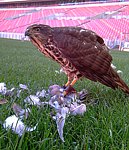
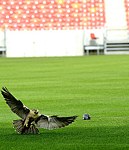
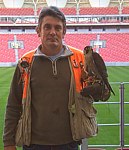
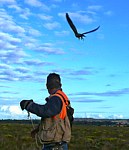
The harsh fact of life is that even indigenous pigeons and doves have adapted to us and our ways and because of this have increased in numbers to pest proportion. Add to this the exotic feral pigeon population and you have a genuine health hazard.
Poor waste management has added crows and gulls to the list of problem species. The adaptability of some indigenous species such as Hadeda Ibis and Egyptian geese has also brought their numbers to naturally unsustainable numbers. Our creation of artificial open areas such as playing fields and agricultural lands has caused a population explosion in these species.
Fact:
Egyptian geese are extremely aggressive when breeding and they chase other waterfowl away. The result is that teal and other smaller waterfowl have fewer areas to breed as the geese and their offspring “hog” every bit of water. Some of our storage dams have thousands of geese roosting on them and the faecal matter they deposit is a health concern.
The only practical and effective way of bird control is a multi-functional approach.
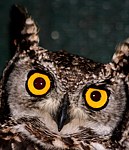
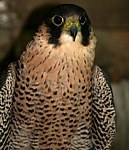
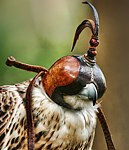
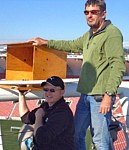
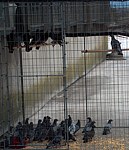
Trapping:
A trap can be set in any secure area and moved around site. It needs experience and regular attention to humanely manage an effective trapping system. On an average we trap in excess of 8 000 pigeons a year at the various sites where we work.
Trapping backs up disturbance of the birds and the use of trained or wild falcons.
Raptor nest boxes:
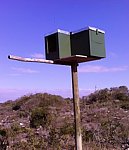

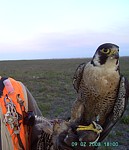
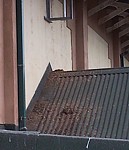

10 years ago there were no active African peregrine nest sites in town, now we have 4. Two are in raptor nest boxes set up by myself in the 1990’s.
We have 21 nest boxes in use by the following species:
• 14x prs Rock kestrels
• 5 x prs Barn owls
• 2 x prs of African Peregrines
Nothing puts fear into pigeons and other birds like the silhouette of a falcon. Falcons already hunt in urban areas every day but you want to encourage them to set up territory and breed. The reason is that for the two month period a pair of African peregrines raise chicks they will require over 400 pigeon/dove sized birds and the pair’s yearly requirement is in the region of a thousand birds [incl. raising chicks].
I have even witnessed the humble Rock Kestrel raiding pigeon nests and catching young pigeons and doves, particularly when breeding. The Rock Kestrel is by nature a very effective small bird and rodent hunter, making him a welcome addition to the natural pest control arsenal. Barn owls and Spotted eagle owls include roosting birds , snatched at night, in their diet on a regular basis.
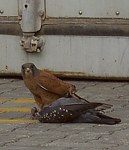
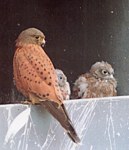
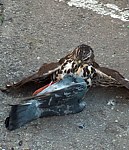


Interesting facts:
Some interesting facts from the personal observations of myself.
Arnold Slabbert says, "Spotted eagle owls take prey up to the size of young hares and three-quarter grown guinea-fowl."
"One active Barn owl breeding pair only catches birds and another pair exclusively house rats. Both pairs have access to other species yet concentrate exclusively on their chosen quarry."
Disturbance:
If birds don’t sleep well they stress and they stop breeding. Continuous pressure on roosts is also an effective way of deterring birds. Barn owls in particular are very effective at hunting roosting birds.
Gimmicks and gadgets:
Bird Scarers:
I have been asked about “bird scaring” devices. These are ultimately expensive and ineffectual because they are based on the false premise that sound/strange noise permanently scares birds. It may do so temporarily but in the long –term the birds adapt and then ignore. [This is why every city in the world has major pigeon problems]. Even more gimmicky are devices that allege to make bird of prey calls which frighten the problem birds. I have hunted and trained almost every bird of prey that can be trained in South Africa. No bird of prey makes any noise when hunting, surprise being the key element of their hunting. The only sound raptors make is territorial calling and calling to chicks/juveniles. The noise/call of a raptor is not disturbing to prey species and in a noisy factory some weird noise even less so.
The secret to bird control is not just to scare the birds, as they just temporarily re-locate elsewhere, but to permanently remove them! Especially if it means through some predators digestive tract…..
Some interesting facts from the personal observations of Arnold Slabbert:
Q:What raptor pellets/castings taught me?
A:In the Mandela Bay Metro the main diet of the urban female African Peregrines is feral pigeons and the male peregrines catch mainly European starlings. Once breeding starts and the chicks hatch the males catch more feral pigeons.
Although Speckled/Rock pigeons are plentiful in the CBD they don’t feature in the urban peregrines diet. The “Rocky is by nature fast and devious and is in a lot of areas replacing the feral pigeon as the main problem species.
Welcome to our world…..please use the contact form to drop us a line & we will contact you.


